| |
This report details SembCorp's environmental and socially responsible practices and performance for the year. As our listed Marine & Offshore Engineering business separately reports such activities in its own annual report, the scope of this report covers our wholly-owned Utilities and Environmental Management businesses. We have focused in particular on our Singapore operations, which substantially account for our Group profit and turnover. Information from our operations in the UK has also been included.
In this section, we focus primarily on environment, health and safety (EHS) as well as community involvement. Our people development initiatives and practices are separately covered in the Human Resources section of this Annual Report. We recognise that the information contained in this report is not yet comprehensive. However this report nonetheless constitutes one of a series of steps towards our ultimate aim of working towards triple bottom line reporting. |
| |
| |
| |
SembCorp Industries strives to be a leader-setting standards for the industry. We are committed to responsibly serving our community and safeguarding the environment. We aim to conduct all business operations in a manner that ensures the health and safety of our customers, employees, the communities in which we operate and our ecological system.
Understanding the importance of health, safety and the environment, we will: |
|
| |
|
Assist the community by offering products, services and solutions that will better conserve and protect our environment |
|
Encourage conservation and recycling in an effort to increase participation in recycling and promote environmental awareness among our staff and community |
|
Ensure safe operations, while minimising impacts on the environment and the communities in which we operate |
|
| |
| |
As part of our ongoing efforts to improve our operations in a responsible and environmentally sustainable manner, we will also: |
|
| |
|
Comply with existing environmental health and safety laws and legislation in all our operations |
|
Continue research, development and employee training and education in order to conduct business in a responsible manner |
|
Conduct careful review of all procedures to improve performance and quality, with constant consideration of environmental factors |
|
| |
| |
| |
SembCorp recognises that in order for us to be a truly successful company, we must behave as a responsible corporate citizen and be committed to improving he world around us. This commitment shapes our present and future actions. We aim to manage our impact on the environment, safeguard the health and safety of our employees and contribute to the communities in which we operate.
In line with this, we believe that integrating environmental, health and safety considerations into our business practices is not only the right thing to do, but also good for our business. It helps us to manage risk better, lower costs through improved efficiency, increase our value as an investment and grow our business in an ethical and sustainable manner. |
| |
|
|
|
Wilton 10, a 30-megawatt wood-fuelled power station and one of the UK's largest renewable energy projects |
|
|
|
Efficient combined heat-and-power (cogeneration) plants in China, Singapore, the UAE and the UK |
|
|
|
First commercial importer and retailer of natural gas in Singapore |
|
Supplier of compressed natural gas to Singapore's transport sector |
|
| |
Water and wastewater treatment |
|
|
Industrial water reclamation, wastewater treatment and recycling plants in China and Singapore |
|
| |
Recycling and waste-to-resource |
|
|
Recovery of processed lead from used lead acid batteries |
|
Recovery of plastic resin and resin pellets from waste plastics |
|
Recycling and trading of waste paper |
|
| |
| |
| |
Our approach to incorporating EHS considerations into our business operations is based on four principles: investment in green business lines, implementation of sound internationally recognised EHS management systems, integration of EHS measures into our business processes and coordination with our business partners and suppliers on EHS improvements.
Firstly, we actively invest in green business lines, which form a part of our core operations. We do not see these as mere add-ons, but as financially viable businesses that will give us a competitive edge in an increasingly resource-scarce world.
Secondly, we implement sound and internationally recognised EHS management systems. Each of our businesses is responsible for managing its own EHS performance and initiatives. When possible, we integrate our environmental, quality and safety measurement systems and have achieved certification under ISO 9001, ISO 14001 and Occupational Health & Safety OHSAS 18001. |
| |
 |
| |
Thirdly, we continually aim to enhance the environmental friendliness and safety of our processes, products and services through integrating EHS measures into our business processes as well as through ongoing feedback and innovation. Audits are incorporated into our operations to strengthen the functioning of the EHS management systems. To drive staff commitment and build an organisationwide safety culture, employees are assessed on their EHS performance.
We also actively encourage staff at all levels to contribute ideas and suggestions from an operational perspective to improve workplace practices and products and services, including their environmental safety and impact on employee health. Outstanding solutions are rewarded at our annual intra-Group Innovate, Discover, Engineer and Achieve (IDEA) Awards.
Fourthly, we work closely with our partners and suppliers for mutual EHS improvement to effect a more far-reaching positive impact. |
| |
| |
In 2006, major steps were taken to transform SembCorp into a more focused group. These included the divestment of our Engineering & Construction and Logistics businesses, as well as the transfer of Utilities' Offshore Engineering business to our listed Marine & Offshore Engineering subsidiary. Following these changes, SembCorp is now clearly focused on Utilities, Marine & Offshore Engineering and Environmental Management. In addition, individual businesses have also implemented organisational changes to increase synergy and operating efficiency. These significant changes have given rise to the need for a review of our current EHS policies and management systems.
Notwithstanding this, in 2006, we have taken a number of steps to move our businesses towards more environmentally and socially responsible practices. We have continued with our green business lines as components of our core businesses and have also taken measures to improve the environmental friendliness of our production processes. These measures include converting all of our Singapore boilers to run on natural gas, developing a new effluent recovery plant on Jurong Island and building a wood-fired power plant in the UK, which will be deemed carbon neutral.
In the area of health and safety, we have launched a dynamic programme at our Singapore Utilities operations to reduce our injuries, spills, non-compliances, hazardous releases and unplanned shutdowns to zero. A high level of staff commitment to this programme has resulted in a dramatic improvement in on-site health and safety.
Our community involvement continued under the auspices of the Trailblazer-Wong Kok Siew Fund. In addition, we held a group-wide corporate social responsibility (CSR) event in September 2006 to raise funds for the Children's Cancer Foundation. |
| |
| |
| Based on an evaluation of the greatest potential impact of our Utilities and Environmental Management businesses, we have identified several key concerns for these businesses: clean air and climate change, water, waste as well as health and safety. Along with these, we also maintain an ongoing commitment towards charity and the community. Our initiatives to monitor and manage these key concerns are discussed in the paragraphs below. |
| |
| |
| As SembCorp is in the power generation business, our impact on climate change and clean air is a key concern for us. We strive to limit and manage our environmental impact in this regard through improving the efficiency and environmental friendliness of our power plants and fuels and also through the monitoring of our emissions and energy use. |
| |
| Efficient power generation |
In carrying out our power generation business, we leverage on technology for greater efficiency and lower emissions.
Our plants in China, Singapore, the UAE and Vietnam make use of combined cycle gas turbine technology, where waste heat from gas turbines is used to make steam to generate additional electricity via steam turbines. This enables us to generate more electricity from the fuel input.
In addition, we operate combined heat-and-power or cogeneration plants in China, Singapore, the UAE1 and the UK. Cogeneration refers to the production of both electricity and heat from a single fuel at a facility located near the consumer. Considered the most efficient use of fuel, cogeneration further improves the overall recovery of heat and also saves the fuel that would otherwise be used to produce heat or steam in a separate unit. Cogeneration plants also generate substantially lower emissions compared to conventional power plants.
A pioneer in cogeneration in Singapore, SembCorp's natural gas-fired cogeneration plant, which produces both electricity and steam for sale to customers, remains Singapore's largest and most efficient today. |
| |
| Natural gas |
SembCorp is Singapore's first commercial importer and retailer of natural gas. Considered the cleanest of all fossil fuels, natural gas produces virtually no particulate waste when combusted and less greenhouse gases per unit of energy released compared to coal or oil.
In 2006, our Utilities operations in Singapore successfully converted all boilers to run on natural gas as a primary fuel, with fuel oil as a backup. Prior to this conversion, our five boilers were running on 1% sulphur fuel oil. As a result of the conversion, our greenhouse gas emissions have been reduced and boiler efficiency has increased to about 93.5%, from an original design efficiency of 90% to 91%. With the clean-burning nature of natural gas, the need for boiler maintenance has also been reduced. |
| |
| Energy from renewables |
The use of renewable and recycled resources for power generation generates less emission of greenhouse gases compared to fossil fuels. The use of biomass is also generally classed as a carbon-neutral process because the carbon dioxide released during the generation of energy is balanced by that absorbed by plants during their growth.
In 2006, SembCorp's UK Utilities operations continued construction of a wood-fuelled biomass power plant, Wilton 10, in the northeast of England. The 30-megawatt wood-fuelled power station is set to become one of the UK's largest renewable energy projects. The plant is expected to come on-line in the second half of 2007. |
| |
| Emissions & energy usage monitoring |
| In 2006, we significantly reduced the absolute amount of carbon dioxide emitted by our Utilities operations in Singapore and the UK. We will continue our efforts to reduce our carbon dioxide emissions going forward. |
| |
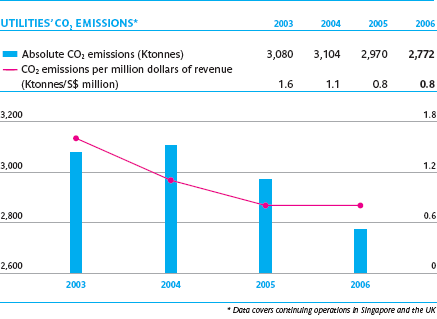 |
| |
| We also recognise that reducing our energy usage can also contribute to lessening our climate change impact. This year, we have achieved a significant reduction of electricity use per million dollars of revenue at our Singapore Utilities operations, as shown in the chart below. |
| |
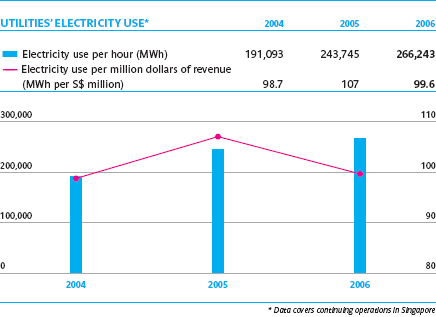 |
| |
| |
| At SembCorp, we limit our negative impact on water resources through our business of industrial wastewater treatment, which also serves as a renewable source for the production of industrial water products for our customers. In addition, we also monitor our consumption of water for our utilities operations. |
| |
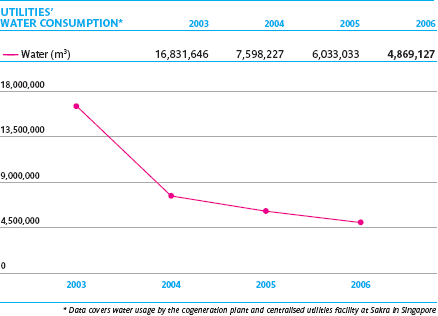 |
| |
| Production of industrial process waters from recycled industrial effluent |
SembCorp's Utilities arm provides a full range of water-related utilities services to predominantly industrial clients. In providing our clients with industrial process waters, we reuse and recycle water in order to reduce the total withdrawals made on fresh water supplies and lessen discharges to sewerage systems and waterways. Today, our demineralised water supply is substantially derived from recycled water. In Singapore, SembCorp was also the first local company to produce high purity demineralised water by reclaiming secondary effluents from dynamically complex industrial wastewater.
In 2006, we started a new effluent recovery plant, which recycles up to 5,000 cubic metres of effluent water per day to produce demineralised water. |
| |
| Industrial wastewater treatment |
In addition, our wastewater treatment activities reduce our clients' water-related environmental impact. Industrial wastewater is traditionally considered difficult to treat due to its dynamic complexity. SembCorp, with industrial wastewater treatment plants in Singapore's Jurong Island, as well as Nanjing and Zhangjiagang in China, has the specialised expertise needed to treat such effluents to meet environmental limits. These solutions have reduced the impact of effluent discharge into the sea, thereby benefiting the environment.
In 2006, we treated over one million cubic metres of industrial wastewater in Singapore alone. In addition, we developed a new 1,272 cubic metres per day plant in Singapore to treat high chemical oxygen demand (COD) wastewater. Our ability to operate this plant, which provides the specialised treatment required for high COD wastewater, further demonstrates our broad expertise in industrial wastewater treatment. |
| |
| Desalination |
| In addition to recycling wastewater, we have strong capabilities in the desalination of water. In the UAE, SembCorp's Utilities business co-owns a combined water and power plant in Fujairah. This encompasses a desalination plant, which at 450,000 cubic metres per day is one of the largest in the world. In arid regions such as the Middle East, desalination provides a renewable source for both industrial and potable water. In Fujairah, our desalination activities also mean that the water necessary for our on-site power generation facilities is obtained from renewable sources. |
| |
| Water usage |
| We also are mindful of the impact of our own water consumption for business use and of the need to monitor and limit this. This year, we are able to report water use by our Singapore Utilities' operations' Sakra centralised utilities facility and cogeneration plant. The graph above shows that their water consumption has declined steadily over the last few years. |
| |
| |
| At SembCorp, we endeavour to reduce landfill and incineration through reducing waste. |
| |
| |
| Supporting national recycling efforts |
| Our Environmental Management arm, which is Singapore's largest environmental management player, supports national recycling goals. It provides collection of separated recyclables as part of its waste collection service to municipal customers. We also operate a materials recovery facility, where recyclable items from waste may be sorted for recycling, as well as a plant for the recovery of construction and demolition waste. |
| |
|
| |
| Practicing recycling |
| To reduce the waste that we generate, we practice recycling both in our offices as well as at our operations sites. For instance, at SembCorp's offices in Singapore, paper recycling bins are placed in convenient locations to raise employee awareness and encourage paper recycling. Meanwhile, our Utilities operations in the UK recycles items from its sites such as commercial and industrial waste, fluorescent tubes, heavy fuel oil and waste electrical and electronic equipment items. |
| |
| Reducing our production of waste |
| We have also improved our industrial operations to reduce the generation of waste that would go to landfill or incineration. For instance, our Utilities arm reduced the waste sludge extracted from its integrated wastewater treatment plant at Jurong Island by 80%, through technical improvements to the plant to convert aerobic biomass to anaerobic biomass. |
| |
| Investments in ULAB and plastics recycling |
| In 2006, we also made investments in waste-to-resource recycling ventures in China and Singapore. Our Environmental Management arm bought a stake in China's largest used lead acid battery (ULAB) recycling company. In addition, we also bought a majority stake in a Singapore company that produces plastic resin and resin pellets from waste plastics. |
| |
| |
| At SembCorp, we recognise that promoting health and safety is part of our responsibility to our employees and to the community. Key concerns are on-site safety for our Utilities operations and road safety for our Environmental Management operations. |
| |
| On-site safety |
In 2006, we made further progress to embed health and safety measures in our Utilities operations on Jurong Island.
We launched the SCU 5/0 campaign, which encompasses the five goals of zero injury, zero spill, zero non-compliance, zero hazardous release and zero unplanned shutdown. Providing a common platform and a rallying point across all of our Utilities operating sites in Singapore, the programme requires all employees to identify hazards and gaps in activities carried out at their workplaces and eliminate them.
Recognising that staff awareness and commitment is crucial to the success of SCU 5/0, we backed the campaign with comprehensive internal communications. These included a programme launch by top Utilities line managers at a high profile staff event, clear communication of the aims of SCU 5/0 and their importance to business success and high visibility of the SCU 5/0 logo on-site as well as on commemorative T-shirts and stored-value cash cards. We also require operations employees to carry a copy of their personal SCU 5/0 records whenever they are on site.
To further emphasise the importance of this programme, the SCU 5/0 results are tracked by the EHS department and presented at monthly management meetings and staff communication sessions. Staff performance appraisals and bonuses are also tied to SCU 5/0 results.
|
| |
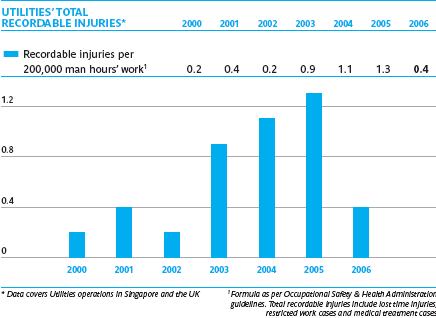 |
| |
The campaign has proven to be a success. Employees have demonstrated a conscious effort to pay greater attention to work processes and to work together as a team to achieve the 5 Zeros. Every employee is fully aware that the goal of 5 Zeros is only possible with everyone-including partners and suppliers-playing his or her respective role. On-site injuries have declined sharply, as may be seen from the chart above.
In tandem with the SCU 5/0 programme, we devised a formula to measure the price of non-conformance, which imputes a monetary cost to lapses relating to the 5 Zeros. Since implementation of the campaign in 2006, the price of non-conformance has dipped substantially compared to 2005.
In 2006, beyond the SCU 5/0 programme, our Singapore Utilities operations sought to promote health and safety through a Safety and Housekeeping Challenge across its six sites on Jurong Island. Every month, plant managers inspect each other's sites and allocate scores for each site's safety and housekeeping efforts. Monthly, a challenge trophy named after the head of Utilities' Singapore operations is awarded to the highest-scoring site, and at the end of the year, the site that has won it most oft en is allowed to keep the trophy. This challenge has created healthy competition among the staff , increased staff awareness of safety and improved housekeeping efforts at all sites. |
| |
| Road safety |
| In 2006, we continued to monitor the road safety of our environmental management operations. The vehicular accident rate per 100,000 kilometres travelled rose from 0.7 in 2005 to 0.8 in 2006. This is of concern for us. We continue to work with the Singapore Traffic Police on yearly educational programmes for our drivers which supplement our in-company continuous improvement programmes, and will endeavour to improve our vehicular safety going forward. |
| |
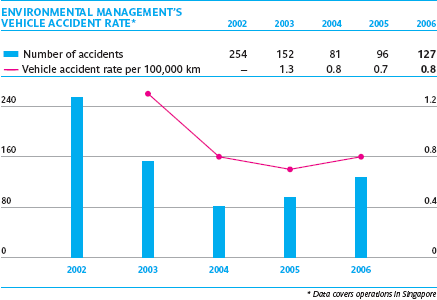 |
| |
| |
| At SembCorp, we recognise that sustainability is primarily about carrying out our business operations responsibly and managing our EHS impacts. However, aside from this, we also recognise that companies can make a positive impact in the community by giving financial and other resources towards meaningful causes. In 2006, we continued to support charitable, educational and cultural causes through direct donations and in-kind support amounting to S$1.5 million as shown in the chart below. |
| |
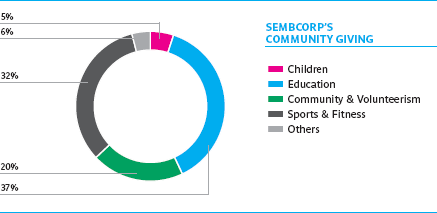 |
| |
| Central to our community efforts is the Trailblazer-Wong Kok Siew Fund, the charitable fund we administer that aims to support children, education, medical research and stroke assistance. The fund started with an initial S$1.2 million and is supplemented by ongoing donations from SembCorp companies. |
| |
Since it was founded just over a year ago, the fund has donated over S$1 million towards its key objectives. These initiatives included core programmes championed by our individual businesses, such as SembCorp Marine's School Book Assistance Grant Scheme, SembCorp Environmental Management's support of the Jamiyah Children's Home as well as community involvement among children and the youth by the Woodlands Wellington Football club, which is sponsored by a division of SembCorp Utilities. The fund has also supported organisations involved with assisting stroke patients in Singapore.
In addition, we tapped the fund to make a positive contribution to overseas communities in which SembCorp operates. In Vietnam, we sponsored books, shelves, computers and a specialised librarian training course to set up the first children's library in Ho Chi Minh City. We also funded scholarships to 250 schoolchildren in Binh Duong Province, where our industrial park is located.
Apart from the activities associated with the fund, we also aim to organise a Groupwide CSR event yearly. In 2006, we organised a fundraising effort in aid of the Children's Cancer Foundation (CCF) in Singapore. A team of 42 employees took part in a 24-hour 70-kilometre walk around Singapore to raise funds. Their efforts were augmented by more than 2,000 employees, associates, friends and staff from our overseas operations, who went on a 5-kilometre walk-a-jog. More than S$420,000 was raised for the children through the fund-raising walks, an appeal for donations and the sale of CCF Tulip Hearts Day merchandise by our employee volunteers. |
| |
| |